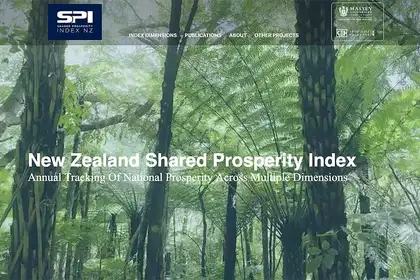
The Shared Prosperity Index can be accessed at www.sharedprosperity.co.nz
When the Government presents its first Wellbeing Budget next week, it will be looking beyond traditional measures, such as GDP, to define New Zealand’s success. This is also at the core of the Shared Prosperity Index launched by Massey University today.
The index calculates well-being and social progress through measuring how well, or poorly, different segments of society have benefited from New Zealand's growing economy. The data is displayed on an interactive, online platform developed by a multidisciplinary team of researchers working at the University’s Knowledge Exchange Hub.
Project leader, Professor Christoph Schumacher from the School of Economics and Finance, says the Shared Prosperity Index measures the gap between the ‘haves’ and ‘have-nots’ in New Zealand society.
“In an economy that fairly shares its prosperity, people believe there is some possibility of social mobility, and that they have the opportunity to realise their potential,” he says. “If they don't believe this, and where they are surrounded by extreme inequalities, they are more likely to feel discontented and resentful.”

Project leader Professor Christoph Schumacher.
Visualising shared prosperity in a granular way
The index uses eight dimensions in its calculations: income and wealth; employment; housing; health; socio-economic wellbeing; education; safety and security; and general equality. An online dashboard shows how the country is performing across each of the eight dimensions, as well as an aggregate index for measuring New Zealand's overall shared prosperity over time.
“It incorporates data from the early 1980s and our calculations show that sharing peaked in 1986, before diving during a period of sweeping reform and economic recession,” Professor Schumacher says.
“Sharing then improved, along with economic prosperity, from the late nineties until 2006. But, after that, it gradually decreased again and the steady economic growth since New Zealand recovered from the Global Financial Crisis has had little impact on the level of sharing.”
Visitors to the website can view the composite index, as well as the data broken down by the eight dimensions.
“You can dive down in the data to a very granular level – each of the eight dimensions is also broken down into contributing variables and there are around 100 different variables in total,” Professor Schumacher says.
“Users will be able to see which of the dimensions has changed the most in any given year, and whether its impact has been negative or positive.”
Professor Schumacher believes the Shared Prosperity Index offers important insights into New Zealand’s collective wellbeing.
“The index contains complementary data to the framework used by the Government to inform its Wellbeing Budget.
“The Government is measuring wellbeing as an overall value, while our index looks at the distribution of prosperity. Put simply, they are asking, ‘How big is the wellbeing pizza?’, while we are asking, ‘How big are the slices of this pizza and who is getting which piece?’”
Access the Shared Propserity Index at www.sharedprosperity.co.nz